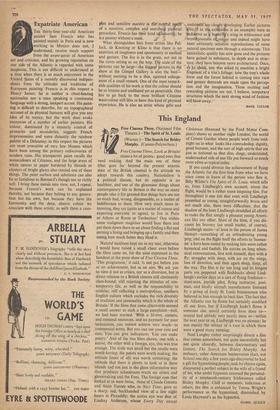Expatriate American
THE thirty-four-year-old American painter 'Sam Francis who has painted mainly in Paris and is now working in Mexico does not, I understand, receive much support from the avant-garde of American art and criticism, and his growing reputation on our side of the Atlantic is regarded with some suspicion. This is not difficult to understand at a time when there is so much enjoyment in the United States ot a recently discovered indepen- dence from the attitudes and traditions of European painting. Francis is in this respect a Henry James; he is neither a chest-beating nationalist nor a man speaking a continental language with a strong, inexpert accent. His paint- ing is difficult to describe, for no topographical account of its physical features will give you any idea of its nature, but the work does evoke memories of a number of earlier painters. His colour, dominated by a masterly control of primaries and secondaries, suggests French impressionism and more distantly the rainbow palette of a Delaunay; in this respect the pictures are most evocative of very late Monets which have been among the primary rediscoveries of modern taste. His transparent paint recalls the watercolours of C6zanne, and the large areas of white canvas or paper bordered by threads or clusters of bright glazes also remind one of these things. The paint surface and substance can also be as fastidious as Bonnard's though not so richly soft. I bring these names into view, not, I repeat, because Francis's work can be explained thereby, not because they belong to any genera- tion but his own, but because they have the luminosity and the deep, elusive colour we associate with these artists; as with them a com- p/ex and sensitive matiere is the:natural resti/t- - of a sensitive, complex and searchirig procedure. Francis has their kind oVsiriccrity; he is a painter without a mask.
What distinguishes him from artists like Pol- lock, de Kooning or Kline is that there is no assertion of toughness and spontaneity in method and gesture. The fire is in the grate, not out in the room setting us on the hop. pie scale, of the pictures can-be large—the bigge1 Picture 'in the show at the Gimpel Gallery is also the hest— without seeming to be a thin, agitated enlarge- ment of a small remark. One of the most remark- able qualities of his work is that the colour should be so intense and undiluted yet so penetrable. One has to go back to the most brilliant Cezanne watercolour still lifer to have this kind of physical
experience. is also an artist whose gifts and
ambiti ti-sacleafily-4eveloping. Earlier pictures in tl- exhibitibn is an example) were as ductive as (ti, bertl's wing in iridescence and 7rnysthriousness o col, r and indeed might have been extremely sensitive reproductions of some natural specimen seen through a microscope. This naturalistic quality has now gone and the pictures have gained in substance, in depth and in struc- ture; they have become more architectural. Once, so to sPeak, One Was asked to examine a bright fragnient of a tree's foliage; now the tree's whole form and the forest behind is coming into view and greater demands are made upon the percep- tion and the imagination. These exciting and rewarding pictures are not, I believe, temporary structures which the next strong wind of fashion will blovt, away.
BASIL TAYLOR










































 Previous page
Previous page